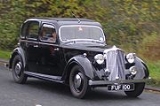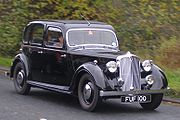
Rover 12
Encyclopedia
The Rover 12 was a name given to several medium sized family cars from the British Rover
car company between 1905 and 1948.

of 1767 cc.
Many of these cars saw use as Taxis.
two-cylinder, water-cooled, sleeve-valve engine of 1882 cc. This had an output of 12 bhp. It is probable that many of the engine components, if not complete engines were bought in from Daimler
who held the British patent rights.
. It had a four-cylinder, water-cooled, side-valve engine of 2297 cc with an SU carburettor made by Rover under licence. Around 5000 were made before World War I. The transmission was three-speed, separate from the engine, and drove the rear axle which had a worm drive. Semi elliptic leaf springs were fitted front and rear. Rear wheel brakes, operated by the hand lever were fitted, with a transmission brake operated by the foot pedal.
Post war, in 1919, the engine got a detachable cylinder head and electric starter. A 6 in (152 mm) longer wheelbase chassis became an option in 1921. Advertisements in 1922 quote open two- and four-seat, saloon, limousine coupé and drophead coupé bodies being available at prices from £625 to £800.
In 1924 the model name was changed to the Rover 14 and a four-speed gearbox fitted although the three-speed remained an option on the open models. There was no change to the engine but the new name was claimed to more closely represent the treasury rating of 13.9 hp. A Weymann
fabric bodied saloon was added to the range. The last of the cars was made in 1924 after around 13,000 had been made.
The bodies were traditionally built with steel panels fitted to a wooden frame. A six light Saloon (£278), four light Sports Saloon with small external boot (£298) and four-seat tourer (£288) bodies were available.
5775 of this version were made.
This car has subsequently become known as the Rover P1.
. The 1938 models had fixed bonnet sides and for 1939 synchromesh was added to the top two ratios on the gearbox. Disc wheels became an option to wire wheels in 1939 and standard on post war models.
11,786 were made pre war and 4840 after.
This car, along with its smaller 10 hp and larger 14/16 hp brothers has become known as the Rover P2.
The final cars were made in 1948 and there was no real replacements as subsequent models featured larger engines.
Rover (car)
The Rover Company is a former British car manufacturing company founded as Starley & Sutton Co. of Coventry in 1878. After developing the template for the modern bicycle with its Rover Safety Bicycle of 1885, the company moved into the automotive industry...
car company between 1905 and 1948.

Rover 10-12 (1905-1907)
The first Rover 12 was the third car the company made and was launched in 1905. It had a four-cylinder, water-cooled, side-valve, monobloc engineMonobloc engine
A monobloc or en bloc engine is an internal-combustion piston engine where some of the major components: cylinder head, cylinder block, or crankcase are formed, usually by casting, as a single integral unit, rather than being assembled later...
of 1767 cc.
Rover 12 (1909-1910)
The new Rover 12 used a two-cylinder, water-cooled, side-valve engine of 1624 cc. The chassis and rear axle of this car would go on to be used in modified form in the 1912 cars.Many of these cars saw use as Taxis.
Rover 12 (1911-1912)
As a complete change the 1911 Rover 12 had a KnightKnight Engine
The Knight Engine was an internal combustion engine, designed by American Charles Yale Knight , that used sleeve valves instead of the more common poppet valve construction.- History :...
two-cylinder, water-cooled, sleeve-valve engine of 1882 cc. This had an output of 12 bhp. It is probable that many of the engine components, if not complete engines were bought in from Daimler
Daimler Motor Company
The Daimler Motor Company Limited was an independent British motor vehicle manufacturer founded in London by H J Lawson in 1896, which set up its manufacturing base in Coventry. The right to the use of the name Daimler had been purchased simultaneously from Gottlieb Daimler and Daimler Motoren...
who held the British patent rights.
Rover 12(1912-1923) and 14(1924)
The new Rover 12 arrived in 1912 replacing all previous models and was designed by Owen Clegg who had joined Rover from WolseleyWolseley Motor Company
The Wolseley Motor Company was a British automobile manufacturer founded in 1901. After 1935 it was incorporated into larger companies but the Wolseley name remained as an upmarket marque until 1975.-History:...
. It had a four-cylinder, water-cooled, side-valve engine of 2297 cc with an SU carburettor made by Rover under licence. Around 5000 were made before World War I. The transmission was three-speed, separate from the engine, and drove the rear axle which had a worm drive. Semi elliptic leaf springs were fitted front and rear. Rear wheel brakes, operated by the hand lever were fitted, with a transmission brake operated by the foot pedal.
Post war, in 1919, the engine got a detachable cylinder head and electric starter. A 6 in (152 mm) longer wheelbase chassis became an option in 1921. Advertisements in 1922 quote open two- and four-seat, saloon, limousine coupé and drophead coupé bodies being available at prices from £625 to £800.
In 1924 the model name was changed to the Rover 14 and a four-speed gearbox fitted although the three-speed remained an option on the open models. There was no change to the engine but the new name was claimed to more closely represent the treasury rating of 13.9 hp. A Weymann
Weymann Fabric Bodies
Weymann Fabric Bodies is a patented design system for fuselages for aircraft and superlight coachwork for motor vehicles. The system used a patent-jointed wood frame covered in fabric...
fabric bodied saloon was added to the range. The last of the cars was made in 1924 after around 13,000 had been made.
Rover 12/4 (P1) (1934-1936)
The new 12 was launched in 1934 and was part of the new range introduced by the Wilks brothers. It had a new 1496 cc, four-cylinder engine producing 53 bhp. The chassis was also new but based on the one seen on the 1933 Speed Pilot and was "underslung" going under the rear axle. The four-speed transmission featured a freewheel mechanism. The suspension was conventional with rigid axles and half elliptic leaf springs all round. The early cars had a 112 in (2,845 mm) wheelbase but this was stretched by 3 in (76 mm) for 1935 with the extra space giving the rear passengers more leg room. A top speed of 70 mph and economy of 24 mpg was claimed in contemporary advertisements.The bodies were traditionally built with steel panels fitted to a wooden frame. A six light Saloon (£278), four light Sports Saloon with small external boot (£298) and four-seat tourer (£288) bodies were available.
5775 of this version were made.
This car has subsequently become known as the Rover P1.
Rover 12 (P2) (1937-1948)
An updated version appeared in 1937 with mainly styling changes but the chassis was stiffened and Girling rod brakes replaced the hydraulic ones that had been fitted to earlier cars. There were no more tourers pre war but around 200 were made in 1947 and 1948 with bodies by TickfordTickford
Tickford is an automobile engineering and testing company with a history of coachbuilding and tuning and is famous for such products as the 140 mph Tickford Turbo Capri.-Early years:...
. The 1938 models had fixed bonnet sides and for 1939 synchromesh was added to the top two ratios on the gearbox. Disc wheels became an option to wire wheels in 1939 and standard on post war models.
11,786 were made pre war and 4840 after.
This car, along with its smaller 10 hp and larger 14/16 hp brothers has become known as the Rover P2.
The final cars were made in 1948 and there was no real replacements as subsequent models featured larger engines.

